“There’s often a visceral point in the interview where the exchange shifts from
a back-and-forth of question-and-answer, question-and-answer to a question-story setup. It’s such a tangible shift in the interview that I feel as if I can
point to it when it happens. Stories are where the richest insights lie, and
your objective is to get to this point in every interview.” – Steve Portigal, Interviewing Users


A night ago, I sat in the center of many of the key problems my classmates and I came to the MFA IxD to solve. We had been asked to go home, write out a problem in the world, big or small, that we wanted to work on and hang them on the walls around the northern classroom. We rotated around the thin perimeter of the room, weaving in and out of one another, reading each challenge statement. Afterward there was a little silence as we tapered off, returning to our seats, and the profound nature of where I found myself struck me; around the room were bits of the stories of these nineteen other people with whom I had come to work.
Thinking of my own problem statement, I felt a vulnerable piece of myself hanging there on the wall. It wasn’t just any challenging issue, chosen at random, that I had pasted there, but one close to my heart that affected those I care for; it was an issue that fueled my pilot light to create and foster change in the world. All these little pilot lights around the room, I thought to myself; I had the image of us all sitting amidst a circle of little flames, the room awash in a visible light of this combined dedication. At barely three weeks in, I am only beginning to learn about the people around me, but here were the beginnings of stories — individuals who wanted to work on education, immigration, healthcare, data and privacy, financial accessibility and management, transportation, and physical and linguistic cultural barriers; what chapters of our lives did these challenges represent?
Stories, their telling, and their interpretation have been central to this program since orientation and each day since. In every class, lecture, reading, and event there is a mention of this human art form and in this way it has been a wildly challenging topic about which to write. How does one write about something so significant, so woven into both the central and the seemingly insignificant parts of our lives, in a way that does the subject justice? How does one tell a meaningful story about story-telling itself?
I ask myself this as I come home each night and sling my bag onto the floor, kick off my shoes and take a deep breath; it’s not the end of the day, arriving home, but the beginning of another section of the day. The way the story of my life operates has changed since joining IxD, where it once followed the gentle ebb and flow of the five-day-work-week tides, it does not stop or start with the sun, nor does it follow any discernible cycle. My moon sits in the sky, waxing and waning, but never resetting with a blank, black sky. I’ll finish a chunk of reading, a sliver of a crescent remains, and then I’ll be struck with an idea for physical computing, picking up a sketchbook from my bedside in the dark, scrambling for a pen; my moon begins to grow.
It’s a strange thing to not think in clear beginnings and endings — have the last three weeks not been one great, long day? I feel borderless here and that is both thrilling and unsettling; I am profoundly free, but without edges, how do I define myself or my world? It’s funny to me that the closest I have ever come to feeling completely open, the human tabula rasa, is when I’m so consumed by thought and work that I have relatively little time for reflection, for defining my own stories. I am consistently learning and creating with little space in-between; never has the Facebook mantra “move fast and break things” made more sense to me than it does here and now. We breathe the work here and rapid-prototyping isn’t so much a skill as a kind of rhythm by which we live.
This wild new sense of time has added new dimension to the work of human-centered-design for me; having a strange sense of its passing makes me appreciate anew the way in which users frame their stories, the value of their moments, the places where they perceive beginnings and endings of their days, hours, interactions, relationships. Where we perceive and create our beginnings and endings in an experience or a day is individual and completely within our hands to define. The way we contextualize ourselves in the world, or the products and services we use in our lives — learning these details from each person now feels a bit like discerning the brushstrokes on a painting and noticing that the whole picture is made of choices and perception, not a reproduction of part of the world we all see and share.
Within the program, we say that “behavior is our medium,” but I might add another layer to our palate, stories are our medium as well, they are what we reverently collect and pull apart to distill the colors we use to paint.
Tacitly or objectively, all human beings know the importance of stories and sharing them; we tell them before we go to bed, as we sit around the campfire and dinner table, over a glass of wine or pint of beer, they’re shared over generations, the borders of countries and in every language. Here, they define the curves of a user-journey and create the delineation between answers and sharing thoughtful, more vulnerable experience. Stories inspire us, teach us about ourselves and one another. Sharing our own stories creates bonds and is a mark of trust, and no wonder when they represent the core of who we are as individuals. What a privilege and a wonder to be allowed up-close, to watch the user add brush-strokes to their own painting and glance openly at us breathing, “This is what it’s like for me.”


